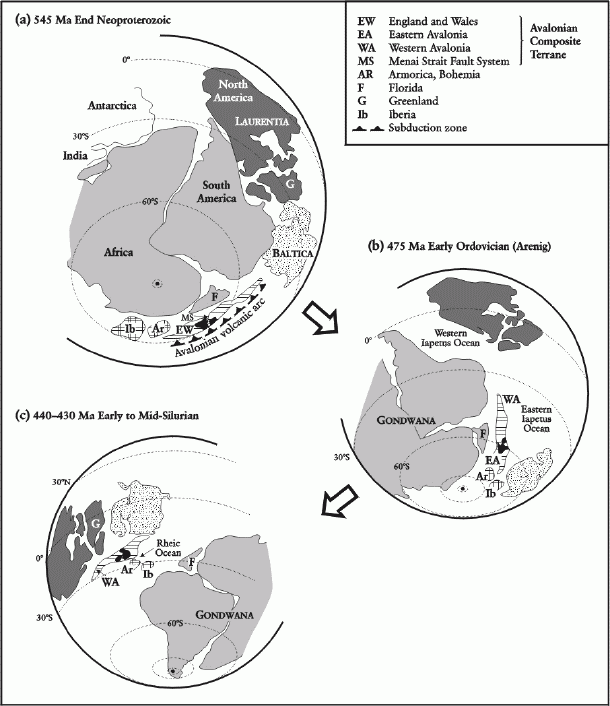Avalonia
Terrane: Early Ordovician to Silurian
Avalonia
Avalonia was an Early Paleozoic microcontinent, more correctly terrane. It has been suggested that Avalonia was originally part of Gondwana after the breakup of Pannotia in the Neoproterozoic. The Ordovician break-up of the Gondwanan margin generated an archipelago of microcontinents, of which Avalonia was the first to rift away. This break-up was produced by continental margin migration across an oceanic spreading centre with associated episodic plume activity. Examination of Avalonian rocks in England indicates that Avalonia itself was assembled from a collection of smaller terranes appended to a Proterozoic supercontinent.
The following is from Donald Kenney's review of the Early Cambrian.
"Avalonian (named for Newfoundland's Avalon peninsula) rocks may possibly may be found in Eastern North Carolina where North American rocks are thrust over beds of similar age non-Laurentian fossils. A few windows exist where the alien rocks are exposed. The faunas of the lower beds are not well enough known to identify the beds as Avalonian. The "Carolina terrane" consists of volcanic rocks and sedimentary rocks of volcanic origin that contain Ediacaran and Atlantic Province Cambrian fossils. Post Cambrian Avalonian rocks are also known from Eastern Maine. Devonian and Silurian rocks of the Upper Connecticut River valley seem to have been deposited about an island arc that existed between Laurentia and Avalonia, but no Cambrian rocks are known from the sequence. The Lower Cambrian-Cambrian boundary in Eastern Newfoundland is set at the appearance of the ichnofossil Trichophycus pedum in the Global Stratotype Section and Point in the Chapel Island Formation at Fortune Head, Newfoundland. Avalonia apparently attached itself to North America in the Ordovician, was later attached to Europe in the Permian and then was fractured when the Supercontinent of Laurasia broke up and the modern Atlantic Ocean opened."
Copyright 1998-2002 by Donald Kenney.
A somewhat more technical and detailed account now:
"...One side of Gondwana consisted of an elongate area that stretched from Belgium via England, Ireland and Maritime Canada into the Appalachians of the USA. Known as the ‘Avalon Composite Terrane’ (Keppie, 1985), or Superterrane (Gibbons, 1990), virtually all its components comprise subduction-related arc magmatic complexes and the sedimentary fill of marginal basins derived from them. The arcs were located on a crust of variable maturity, some on juvenile, perhaps even oceanic, crust, others on more mature crust. These characteristics point to derivation from the oceanward side of a long-lived destructive margin, located either on the North African or South American margin of Gondwana (Figure 1.3a)...
The Paleozoic history of Avalonia is too complex to detail here, but some of the more significant plate movements are shown in Figure 1.3b,c. The earliest of these caused the Avalonian Terrane to be rifted off and moved away from the Gondwana margin in early Ordovician time. The microcontinent subsequently docked with Baltica in the late Ordovician, causing the Shelveian (early Caledonian) deformation event (Toghill, 1992), and was subjected to strong deformation resulting from the Acadian (late Caledonian) deformation, in late Silurian to early Devonian time...

Figure 1.3 Global reconstructions showing the changing palaeogeography of the Avalonian microcontinent from the late Precambrian through to the late Silurian, modified from Dalziel (1997). (a) Reconstruction of the Pannotia supercontinent, showing its main components, towards the end of activity of the Avalonian volcanic arc and prior to the Cambrian overstep sequence. (b) Conjectural position of Avalonia at the time of the Floian (Early Arenig) overstep sequence in England and Wales, and following rifting and the breakup of Pannotia. (c) Situation just before the Acadian deformation, caused by collision when the converging microcontinent of Armorica impinged against Avalonia. Note that Avalonia had earlier 'docked' with Baltica in latest Ordovician time. It was to encroach upon Laurentia in the earliest Silurian, along the line of the Iapetus suture, which is located between the English Lake District and the Southern Uplands of Scotland.
text and graphic © from J.N. Carney, J.M. Horak, T.C. Pharaoh, W. Gibbons, D. Wilson, W.J. Barclay, R.E. Bevins, J.C.W. Cope and T.D. Ford
Precambrian Rocks of England and Wales, GCR VOLUME No. 20, volume 20 (2)
Status: Microcontinent/Composite Terrane/Superterrane
Time: Ordovician to
Devonian
Included the present-day England, Belgium, Wales, Eastern Newfoundland, Northern Nova Scotia, New Brunswick, Eastern Massachusetts, and Rhode Island, and possibly also Greenland and Ireland
Fragmented from: Gondwana
Collided with: Armorica,
Baltica, and
Laurentia to form
Euramerica
ATW080313. Edited RFVS111106
